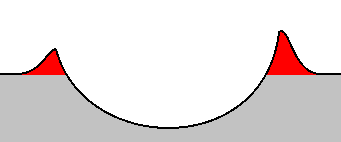Kraterrand
| Den här artikeln behöver källhänvisningar för att kunna verifieras. (2024-02) Åtgärda genom att lägga till pålitliga källor (gärna som fotnoter). Uppgifter utan källhänvisning kan ifrågasättas och tas bort utan att det behöver diskuteras på diskussionssidan. |

Kraterranden är den del av en nedslagskrater som breder ut sig ovan den omgivande ytan, vanligtvis i en cirkulär eller elliptisk form. I en mer specifik betydelse refererar kraterranden till den cirkulära eller elliptiska krönet (en: edge) som representerar den översta toppen av den upphöjda delen. Om det inte finns någon upphöjd del så syftar kraterrand helt enkelt på den inre kanten av kurvan där den plana ytan möter kurvan från kraterbottnen.


Media som används på denna webbplats
Författare/Upphovsman: Tkgd2007, Licens: CC BY-SA 3.0
A new incarnation of Image:Question_book-3.svg, which was uploaded by user AzaToth. This file is available on the English version of Wikipedia under the filename en:Image:Question book-new.svg
A side view of a crater, with the "rim" highlighted in red by using Gimp 2.2.6.
Descripción: formación de un cráter de impacto.
Autor: Luis María Benítez
This image taken by the Mars Exploration Rover Opportunity's panoramic camera shows the eastern plains that stretch beyond the small crater where the rover landed. In the distance, the rim of a larger crater dubbed "Endurance" can be seen.
This color mosaic was taken on the 32nd martian day, or sol, of the rover's mission and spans 20 degrees of the horizon. It was taken while Opportunity was parked at the north end of the outcrop, in front of the rock region dubbed "El Capitan" and facing east.
The features seen at the horizon are the near and far rims of "Endurance," the largest crater within about 6 kilometers (4 miles) of the lander. Using orbital data from the Mars Orbiter Camera on NASA's Mars Global Surveyor spacecraft, scientists estimated the crater to be 160 meters (175 yards) in diameter, and about 720 meters (half a mile) away from the lander.
The highest point visible on "Endurance" is the highest point on the far wall of the crater; the sun is illuminating the inside of the far wall.
Between the location where the image was taken at "El Capitan" and "Endurance" are the flat, smooth Meridiani plains, which scientists believe are blanketed in the iron-bearing mineral called hematite. The dark horizontal feature near the bottom of the picture is a small, five-meter (16-feet) crater, only 50 meters (164 feet) from Opportunity's present position. When the rover leaves the crater some 2 to 3 weeks from now, "Endurance" is one of several potential destinations.


